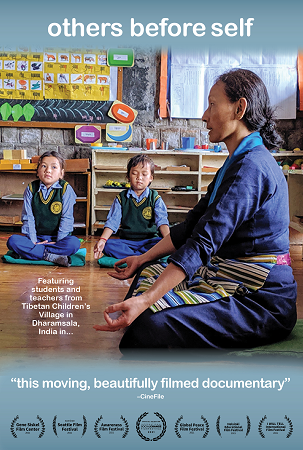
Others Before Self 2022
Distributed by Good Docs
Produced by Seth McClellan
Directed by Seth McClellan
Streaming, 54 mins
High School - General Adult
Asian Studies; Education; Tibet
Date Entered: 04/03/2024
Reviewed by Laura Harris, Web Services & Distance Learning Librarian, SUNY OswegoOthers Before Self is about the Tibetan Children’s Village (TCV), an organization that runs over a dozen schools in India. The students attending these schools are primarily children of parents currently living in Tibet, and children whose parents or grandparents fled from Chinese rule in Tibet.
At the most rudimentary level, these schools provide basic needs for the children, such as food and shelter. These are not boarding schools reserved for the wealthy; as one student interviewed for the film notes, most Tibetans are poor. The core mission of these schools, however, is to help preserve the Tibetan culture, language, and religion – because Tibet is not a safe place to practice any of these things.
The students’ activities are highly structured. In school, they learn about practices of Tibetan Buddhism such as meditation and riglam (dialectic debate). They also take classes in subjects such as language arts and biology. Many classes are conducted in English, and as a result, most of the students develop fluency in English. (All students interviewed in the film responded in English.) In addition to their studies, all students have responsibilities that contribute to the overall good of the community; this is a way for them to practice the Buddhist precept of 'others before self.' The film shows students cleaning communal spaces, doing laundry, preparing meals for one another, and distributing drinking mugs and food.
The idea of 'others before self' is also practiced in other ways. Older students take younger ones under their wing: this can include both practical and emotional support. For instance, students mentioned helping younger ones with chores, or sharing a bed to offer comfort. Newer students are also made to feel welcome; one newer girl spoke about how another girl introduced herself and helped her to feel less nervous about being in a new place. A teacher commented about how students rarely eat alone. As a result, the students have developed strong social bonds.
While some of the students interviewed endured traumatic experiences – primarily those who fled Tibet themselves – the viewer gets the sense that most of the students at TCV enjoy their childhood. There are many scenes that struck a chord with me, as an American viewer, because they depict the same joy, ease, and silliness I see in children here in the United States. In one scene, two boys are shown poking each other with origami figures, and after one boy pokes the other in the eye, the second boy smiles cheesily at the other to let him know he’s okay. Another memorable scene shows a group of boys hamming it up for the camera. In other scenes, the children are shown playing sports, reading, and petting the dogs that are common at TCV.
At the same time, the students have a clear sense of the gravity of the situation in Tibet. There are mixed feelings about the Chinese; some students feel angry and hate them. Others – usually older students – express that they’ve “gotten over” their anger and are more solution-focused. Most students understand the nuance between the government and the Chinese people, and delegate any negative feelings toward the government. Most of the students want to help Tibet regain its independence; while some are more optimistic, others are doubtful independence will happen in their lifetimes.
This film is recommended for a wide variety of audiences. It could be used in high school or college classrooms to supplement other learning activities about Tibet. It would also be of interest to general audiences with an interest in Tibet.
Awards: Best Documentary Award, Socially Relevant Film Festival, NYC; Best Documentary Award, Liberty International Movie Festival, Seoul; Best Karma Award, Awareness Film Festival; Best Socio-Political Film Award, Helsinki Educational Film Festival
Published and licensed under the Creative Commons Attribution 4.0 license. Anyone can use these reviews, so long as they comply with the terms of the license.